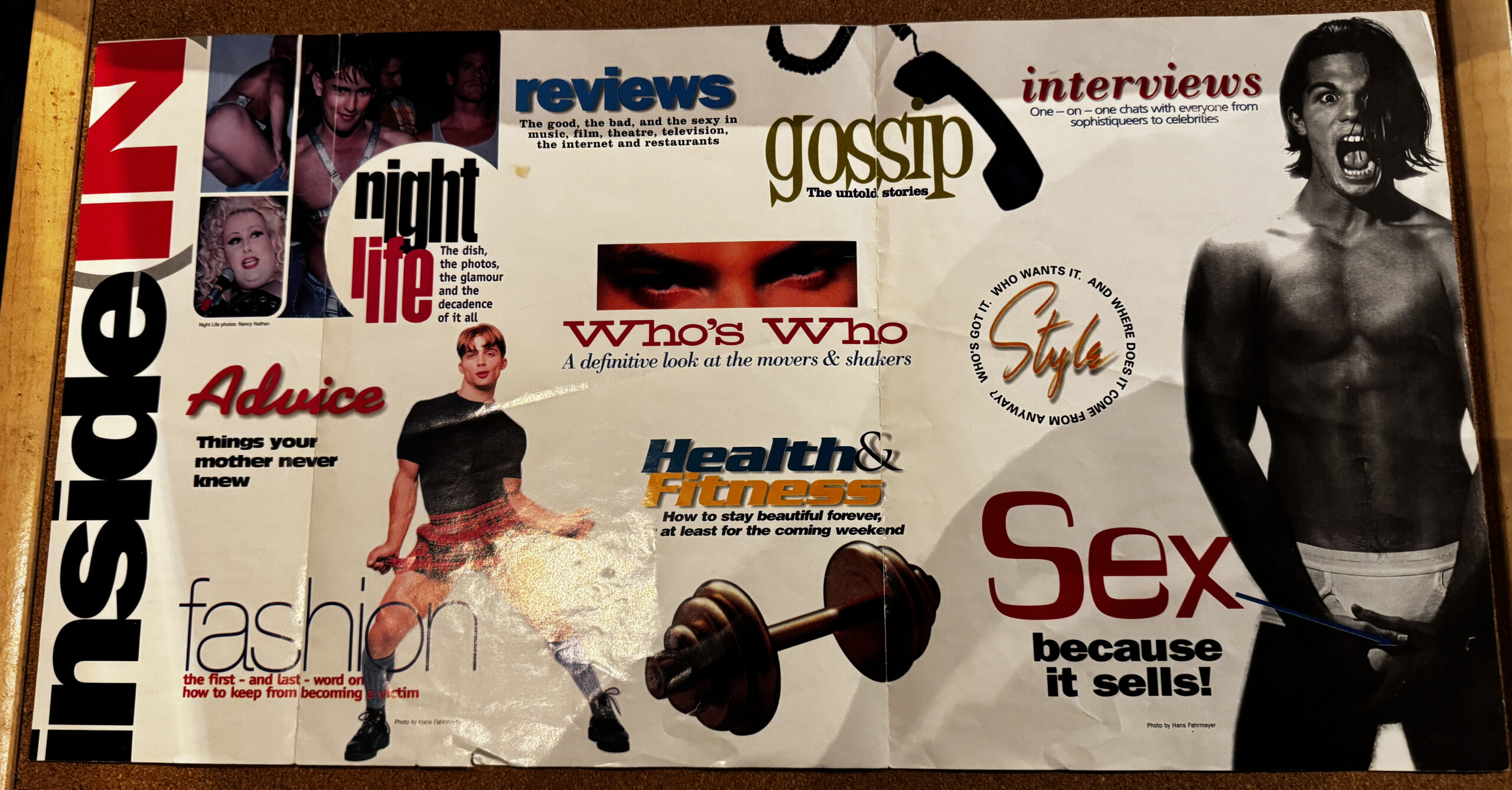

You are completely delusional. There is no point in talking to someone so messed up and narrow-minded. Clearly, you are so invested in ‘gay culture’ (your version of it) that you don’t even know what the real world looks like anymore.
You keep saying I’m avoiding gay culture but don’t define what it is, even though I’ve already said I don’t avoid it, just the club culture. As I mentioned, this magazine has it wrong, but no more wrong than you.” —JUSTME, perpetual commentator
JustMe is probably like you and me. Occasionally, he feels the need to comment on a post found on a popular gay blog. Initially, comments address the story at hand, and then rather quickly dissolve into a tirade of personal attacks. Like a boxer, the writer retreats to his corner for a time, reads the follow-up comments, and then returns with a right uppercut to the jaw—wham! Take that, you ignoramus. And it can go on and on…
There was a time, years ago, when trees were turned into paper, and paper made magazines. During those times, people would write a “letter to the editor.” A gay magazine might receive, on a good month, a hundred letters. Handwritten or typed, these letters expressed some feelings about a story in a recent issue, and they would, after a little help from an editor, be published.
INTER(RE)ACTIVE Then came the Internet, and everything changed. Magazines essentially went the way of the dinosaur, saving hundreds of trees. Born in this era was something with the unpleasant name of a blog—a contraction of the words “web log.” These were journals, diaries, or notes on one’s existence, favoring images and texts that allowed readers into the mind of the writer. A handsome 36-year-old named Andy Towle wrote one such blog, Towleroad, which emerged in 2003. It began like most blogs, as a diary of Andy’s life, featuring short videos (shot by Andy) and observations on his life. For example, in November 2003, Mr. Towle discussed his first encounter with the drink Absinthe, even giving directions on how to prepare it. Another entry shows Mr. Towle being kissed by a rather attractive young man. It was personal. For the record, Andy became a millionaire after selling the website in 2021.
In 2005, David Hauslaib started Queerty. A market watch report from 2005 tells us: Queerty is published by 21-year-old David Hauslaib. He also owns Jossip.com, self-described as a “big bag of rumors” about celebrities and show business in New York. A flurry of gay and lesbian blogs soon followed. For the casual reader, information was now available and packaged in short Entertainment Weekly bites that invited conversation with the reader—something magazines didn’t really do. What few suspected about this phenomenon was that everyone wanted in on the act. A blog took work, a lot of work: daily scouring of the news and Internet for tiny morsels of gay-related information. Once presented, a comments column would allow readers to voice their opinions. And this is where the trouble started. A blogger could be held responsible for their words—they were the author of the blog, that was a given. Comments, on the other hand, were anonymous, shielded by secrecy, and apparently, everyone had something to say. It wasn’t just gay blogs—political blogs, in particular, would begin with a responsible topic only to conclude in a cavalcade of bitch fights, no one really listening, just opining. Somehow, in our delusional minds, we must have thought gay men might be nicer—after all, we were all in this fight for freedom and equality together, holding hands at vigils and lighting our united candles together.
This is not to say that all intelligent conversation has been lost—it hasn’t; it’s just hard to discern. And unfortunately, people get personal. JustMe and LittleKiwi on Towleroad managed to exchange over forty comments on one story alone, usually about each other. And this was a fairly innocuous story about a new gay magazine called HelloMr.
In retrospect, magazines required effort—one had to actually lick a stamp and pray to get their opinion published. Now, it’s all clicks and hiding, and one can be as nasty as words will allow.
And we wouldn’t change a thing. The fact is, this is who we are. We are exceptionally critical as a cultural group. We sharpen our tongues on a wide variety of subjects—sociological, political, sexual. Gay blogs and the Internet have revealed much. Never before has there been a time in history when communication was so vast and expedient. We know more about the mind of a gay man or woman than ever before, not only through the thoughtful, often entertaining world of gay bloggers but also their audience. Just as we know more about the intimacies of the sexual lives of people as revealed in cam websites such as Cam4 and Chaturbate. But we should be cautioned: just as an appearance on one of those websites will reveal us, so too will our comments on gay blogs.”




If you are not familiar with AI, it’s a platform for creating immersive experiences where the artwork responds to the viewer’s presence or actions. These interactive pieces often blur the lines between the creator, the audience, and the art itself. In other words, it is where a creator tells a computer what the image should look like, and the computer, within seconds fires off a few versions and asks if there are any changes.
AI can generate images, including those with adult or erotic content, but such uses are typically restricted or prohibited by most AI platforms. As always, there are ways around that.
So, what does it all mean? If you’re an illustrator, this will affect you—badly—it can create images of quality, quickly and, no one seems to know where they come from. But we had to ask: AI-generated images are created by a type of machine learning model known as a generative model, specifically a Generative Adversarial Network (GAN), Variational Autoencoder (VAE), or Transformer-based models like DALL-E. These models are trained on vast datasets of images and text, learning to generate new images that align with textual descriptions or other inputs.
Confessions of a Gay Art Director
Over the decades I spent a lot of time art-directing gay magazines, such as The Advocate, Genre, Hero, In Magazine, and Out. As one can imagine there are stories to be told and the time has come to tell them. But first, just what is a magazine art director? A magazine AD was the person who put the art and words together to create a style for the magazine that became its brand. It was the “look” of the publication and to do that AD’s would hire photographers and illustrators to complete the writing of the story.
A funny thing about time is how it often distorts the truth. Memories are made solely in the mind, of one person, and other people can see things differently. And often do. But these are my recollections—this is how I remember it.
Let’s start with Genre magazine: Genre was a prominent gay men’s magazine that operated primarily during the 1990s and early 2000s. Founded in 1991 by John Liggins and Michael Turner, it was initially conceived as a lifestyle publication aimed at affluent, style-conscious gay men. Genre was positioned to appeal to a broader, more mainstream audience within the LGBTQ+ community, differentiating itself from other magazines that focused more on adult content or niche audiences. It later brought in Richard Settles as publisher and New York-based co-owner and associate publisher Doug Shingleton.
I was there in 2001, though I had done a few freelance jobs on Genre, working out of Richard Settles’s bathroom. But in 2001, we literally walked the old staff out and brought in Andy Towle as Editor-in-Chief, Michael Davis as Creative Director and I remained as Art Director.
The publisher, Richard Settles, was looking to sell the magazine, and his contributions became less and less with time. The trilogy of Towle, Davis, and Dunbar was a powerhouse, for a time.
About the third issue, as we worked into the evening, a sudden screaming and the sound of papers and books flying came from Andy’s office. He was not happy. He had essentially cleared his desk. In the room was Michael Davis. They had a fight. It was a few weeks later when Richard Settles called Davis into his office and told him he was no longer employed.
Michael Davis is not one to take things lying down so in a week or two he was back as art director at competitor magazine, Instinct.
The cause of that disruption in the Genre office has been a matter of speculation for decades.
Some twenty years later, I asked Michael Davis and he said, “Andy was upset that I brought up the fact that every time we went somewhere, he expected me to pay.” Around the same time, I asked Andy Towle—Andy, to this day has never revealed what happened. He does not speak to Michael Davis.
Richard Settles, looking to retire stopped coming into the office. It was just Andy and I. So, for about a year it was Andy and I creating the magazine. We had editors, none in the office but that occasionally stopped by, but each issue was planned and executed by the two of us.
First meeting Andy Towle—we were at the Abbey, it was late afternoon, and if you are facing West, the sun illuminates a person’s eyes. We were in the middle of the bar, and Andy was looking West and I was talking to him. Andy is a very attractive man. He went to Vassar University, he was smart, short, and easy to look at. I liked him. I liked working with him. I don’t think we ever had a harsh word. We went on an Atlantis Cruise together. We may have liked the same person on that trip, though I always thought Andy could get anyone he wanted and usually did.
We worked on 12 issues. The Sex issue was fun—we did ask author Christopher Rice to join us in a meeting, but it really came back to Andy and I asking questions we had about sex.
In time, the stirring of a sale of the magazine cut short our journey. In 2004, Genre magazine was sold to Window Media, a media company that focused on LGBTQ+ publications. Window Media also owned other LGBTQ+ media outlets such as the Washington Blade and Southern Voice. The acquisition was part of Window Media‘s strategy to consolidate gay and lesbian media under one company to enhance their market reach.
An acquisition and changing of staff is never easy. Andy and I were asked to stay for a few weeks to help transition the new staff. It was terrible. We were treated badly. Andy went over to another gay magazine and I went to Out magazine as an interim Art Director. To follow Andy Towle with editor-in-chief Brendon Lemon was a huge disappointment.
The magazine changed hands many times.




In and Out
After a disastrous year at the Advocate, it was time to get local—Weho loco, in the form of what is. commonly called a rag, IN magazine. It was published by Frontiers magazine. Frontiers was Southern California’s oldest and largest lesbian, gay, bisexual, and transgender (LGBT) magazine. Founded in 1981, it was distributed freely at gay bars, clubs, and businesses throughout Southern California. The biweekly publication focused on local, national, and international news related to the LGBT community, entertainment, as well as coverage of HIV/AIDS-related topics and other important issues, in addition to its popular escort listings section, Frontiers4Men. As of February 2014, it had a staff of 19 and claimed a readership of 270,000. The good old days.
IN magazine was another thing entirely.
Our offices were down the street. We had little to do with Frontiers other than visit the publisher, Bob Craig, once in a while. While he was the publisher, the actual owners and founders of the magazine were David XXXX and Mark Hundahl.
This was what was called a “start-up.” It didn’t exist as a magazine, only an idea. So, the creation of the magazine fell to me—I didn’t trust myself enough to do both the editor and creative director jobs, so I decided to find an editor.
JV MAuley was one the funniest people I have ever met.
His wit was quick and rampant. He was in many ways like a Robin Williams character—energetic, fun, and engaging.
He had created a drag persona, Shelvelva Kennedy.
